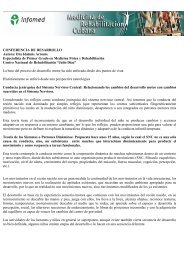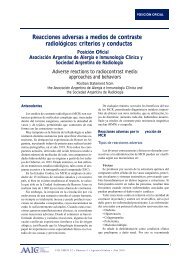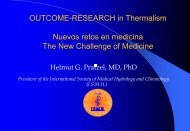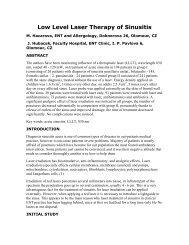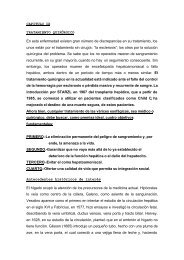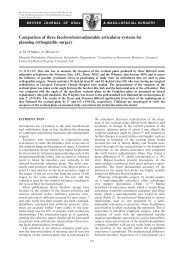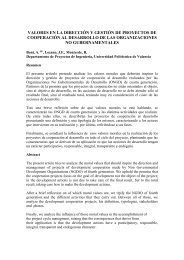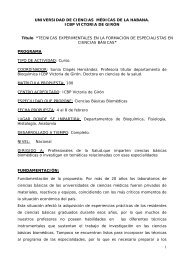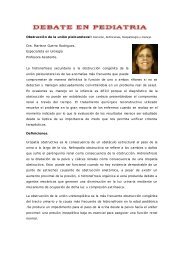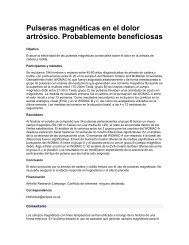pharmacology of medicinal plants and natural products
pharmacology of medicinal plants and natural products
pharmacology of medicinal plants and natural products
You also want an ePaper? Increase the reach of your titles
YUMPU automatically turns print PDFs into web optimized ePapers that Google loves.
MEDICINAL PLANTS (NATURAL PRDUCTS)<br />
S93<br />
(40%) induced toxicity in isolated rat hepatocytes 133 .<br />
I also showed a dose dependent hepatoprotective<br />
effect against oxytetracycline induced hepatic damage<br />
in rats 134 . The protective effect <strong>of</strong> picroliv against<br />
hepatic damage caused by Plasmodium berghei infection<br />
in Mastomys caucha was studied by Ramesh<br />
et al 135 . Treatment with this drug significantly reversed<br />
the changes in lipid metabolism induced by Plasmodium<br />
berghei. It reactivated the plasma <strong>and</strong> liver lipolytic<br />
enzymes, stimulated the binding <strong>of</strong> LDL with the<br />
liver receptors <strong>and</strong> enhanced the faecal excretion <strong>of</strong><br />
bile acids, thus resulting in a return <strong>of</strong> circulatory<br />
lipoproteins towards normal.<br />
Santra et al, 136 demonstrated that treatment with<br />
Picrorrhiza kurroa in carbon tetrachloride treated<br />
mice significantly reversed the altered serum ALT,<br />
AST, liver GSH, total thiol, glucose 6 phosphate<br />
dehydrogenase (G6PD), catalase <strong>and</strong> membrane<br />
bound Na + /K + ATPase levels. Histopathological lesions<br />
<strong>of</strong> liver <strong>and</strong> lipid peroxidation were also significantly<br />
less in drug treated animals. Probable mechanism<br />
<strong>of</strong> action <strong>of</strong> Picrorrhiza kurroa appears to be its<br />
effect as a free radical scavenger <strong>and</strong> inhibitor <strong>of</strong> lipid<br />
peroxidation <strong>of</strong> liver plasma membrane.<br />
The diterpenes, <strong>and</strong>rographolide, <strong>and</strong>rographiside<br />
<strong>and</strong> neo<strong>and</strong>rographolide, isolated from Andrographis<br />
paniculata demonstrated anti-oxidant effects in CCl 4<br />
treated mice. Neo<strong>and</strong>rographolide was as effective<br />
as silymarin with respect to its effects on reduced<br />
glutathione, glutathione 5-transferase, glutathione<br />
peroxidase <strong>and</strong> superoxide dismutase <strong>and</strong> lipid<br />
peroxidation whereas <strong>and</strong>rographiside had mainly<br />
anti-lipoperoxidant activity 137 . Administration <strong>of</strong> the<br />
aqueous extract <strong>of</strong> Andrographis paniculata to mice<br />
suffering from liver damage induced by hexachlorocyclohexane<br />
(BHC) that ultimately leads to tumor formation,<br />
significantly lowered the raised enzymes<br />
(SGPT, SGOT, alkaline phosphatase) <strong>and</strong> raised the<br />
lowered protein concentration. The results confirm<br />
the hepato-protective property <strong>of</strong> Andrographis<br />
paniculata <strong>and</strong> suggest its probable role in delaying<br />
the hepatic tumorigenic condition 138 .<br />
Administration <strong>of</strong> Liv-52, a polyherbal formulation,<br />
significantly improved ethanol metabolism in a rat<br />
model <strong>of</strong> chronic alcohol administration 139 . It also prevented<br />
lipid peroxidation in CCl 4<br />
induced liver damage<br />
as seen by a significant decrease in malondialdehyde<br />
content 140 . Both, Liv-52 <strong>and</strong> another formulation<br />
Kumaryasava were found to stimulate depressed<br />
hepatic enzyme activities such as hepatic<br />
arginase, cathepsin B, acid phosphatase <strong>and</strong> ribonuclease<br />
in CCl 4<br />
induced liver damage indicating that<br />
these drugs have a protective effect on hepatic enzyme<br />
activity 141 .<br />
Liv. 100 is an improvised herbal formulation <strong>of</strong> Liv52.<br />
In an in vitro study combination <strong>of</strong> Liv52 <strong>and</strong> Liv100<br />
reduced the peroxidation effect <strong>of</strong> hydrogen peroxide<br />
in rat liver homogenate. The protective effect <strong>of</strong><br />
these drugs was attributed to the enhanced supply<br />
<strong>of</strong> reduced glutathione that inhibited the deleterious<br />
process <strong>of</strong> lipid peroxidation. This suggested the antioxidant<br />
potential <strong>of</strong> Liv. 52 <strong>and</strong> Liv. 100 142 . Simultaneous<br />
administration <strong>of</strong> Liv-100 with the anti-tubercular<br />
drugs, INH, rifampicin <strong>and</strong> pyrazinamide showed<br />
significant protection against hepato-toxic effects <strong>of</strong><br />
the anti-tubercular drugs in rats 143 .<br />
The hepato-protective effect <strong>of</strong> Jigrine, an Unani<br />
polypharmaceutical herbal formulation containing 14<br />
<strong>medicinal</strong> <strong>plants</strong>, was evaluated in 3 models <strong>of</strong> hepatic<br />
damage induced by either alcohol, carbon tetrachloride<br />
or paracetamol in rats. Jigrine significantly<br />
reduced the increased serum transaminases, bilirubin,<br />
prothrombin time <strong>and</strong> liver lipid peroxide content<br />
<strong>and</strong> also improved the histopathological findings.<br />
The authors have attributed its hepato-protective effect<br />
to its anti-oxidant property 144 . Further studies carried<br />
out on Jigrine by the same group showed that it<br />
also reduced the levels <strong>of</strong> gamma-GTP, triglycerides<br />
<strong>and</strong> lipid peroxides in the liver, confirming its membrane<br />
stabilising <strong>and</strong> antioxidant properties 145 .<br />
The importance <strong>of</strong> morphological features <strong>and</strong> time<br />
<strong>of</strong> collection <strong>of</strong> raw material can be understood from<br />
a study conducted by Rawat et al, 146 at the National<br />
Botanical Research Institute. The effect <strong>of</strong> seasons,<br />
root thickness <strong>and</strong> dosage forms (aqueous or powder)<br />
on the hepato-protective activity <strong>of</strong> Boerrhavia<br />
diffusa (Punarnava) was evaluated in thioacetamide<br />
intoxicated rats. Results showed that aqueous extract<br />
<strong>of</strong> roots <strong>of</strong> diameter 1-3 cms, collected in May<br />
(Summer) exhibited marked protection as determined<br />
by assessing serum enzymes viz. SGOT, SGPT, ACP<br />
<strong>and</strong> ALP, but not GLDH <strong>and</strong> bilirubin. Furthermore,<br />
the studies have shown that the aqueous form <strong>of</strong> the<br />
drug has more hepato-protective activity than the<br />
powder form, probably due to better absorption <strong>of</strong><br />
the liquid form.




